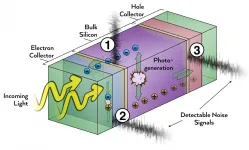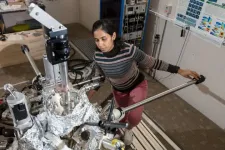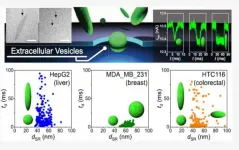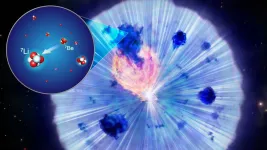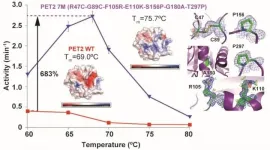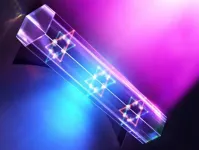(Press-News.org) As society moves towards a renewable energy future, it's crucial that solar panels convert light into electricity as efficiently as possible. Some state-of-the-art solar cells are close to the theoretical maximum of efficiency--and physicists from the University of Utah and Helmholtz-Zentrum Berlin have figured out a way to make them even better.
In a new study, physicists used a technique known as cross-correlation noise spectroscopy to measure miniscule fluctuations in electrical current flowing between materials inside silicon solar cells. The researchers identified crucial electrical noise signals that are completely invisible to conventional noise-measuring methods. They were also able to pinpoint the likely physical processes causing the noise, which often results in a loss of energy and lower efficiency.
"Measuring noise on an object is relatively simple. You can just buy devices that do it. But the problem that plagues us is that these devices also have noise," said Kevin Davenport, associate instructor of physics at the U and lead author of the paper. "This cross-correlation technique allows us to not only measure the noise of the device, but to also measure the noise of our detector and remove it so that we can see much, much smaller noise signals."
The technique, that was published on June 24 in the journal Scientific Reports, is an important new tool to improve material interfaces for a better solar cell, or to analyze inefficiencies in other complicated devices.
"It's surprising how important tiny improvements in efficiency is for industry. Just a fraction of a percent improvement translates into billions of dollars because of the scale of production," said co-author Klaus Lips, professor of physics at Freie Universität Berlin and department head at Helmholtz-Zentrum Berlin where the solar cells have been designed and fabricated.
"In the past, we have used the cross-correlation technique to study fairly simple research-grade light emitting diodes, but advantages of the method truly came into the light in this work," said Andrey Rogachev, professor of physics at the U and co-author of the study. "And it goes beyond the solar industry. In any device with many layers, each interface between materials can diminish efficiency in some way. It's so complicated, you have to be really discreet to be able to say what's going on and, more importantly, where the particular noise is happening. It turns out that this technique allows us to do just that."
As often happens in modern research, a single method was not enough to understand complex devices. Interpretation of the noise date have been heavily helped by solar cell simulations carried out by C.T. Trinh, a postdoctoral researcher at Helmholtz-Zentrum Berlin and co-author of the study. The final co-author is Mark Hayward, then an undergraduate research at the U and now a graduate student at University of California, Irvine.
Analyzing noise
The study analyzed silicon heterojunction solar cells (HSCs), a high-end type of single-material solar cell and currently the most efficient of its kind on the market--26.7% of light that hits the cell is converted into electricity. In contrast, the cells that make up solar panels on a residential house range between 15% and 20% efficiency.
In an HSC, electricity generation starts when individual particles of light called photons are absorbed by the photo-active layer made of crystalline silicon and creates pairs of negatively charged electrons and positively charged holes, which are charges caused by missing electrons. Electrons and holes are then pulled in opposite directions by an electrical field created by two selective contacts made of hydrogenated amorphous silicon modified with impurities. This process produces current that we use as electricity. The problem is that the selective electrode and photo-active silicon do not match together perfectly, creating defects that trap electrons. To eliminate these defects in research-grade solar cells like the ones in the study, the scientists place between them an ultrathin layer of pure amorphous silicon. Finally, all of these five layers are sandwiched between two layers of transparent conducting material, known as ITO, and gold electrodes.
The efficiency of HSCs depends on how well the different layers are connected together. A slight mismatch between two layers can make it difficult for the electrons to get where they need to go--a problem that will produce a noise signal.
"That problem is kind of hidden inside these interfaces, and it's really difficult to be able to detect any kind of signal. But the noise technique that we use is very sensitive to really, really small individual signals," said Davenport. It's like listening to a note played by different instruments, he continued. A C-note on a violin is the same as a C-note on a cello, but they sound different. If you were to analyze that note, you can pull out information to learn something about the instrument that produced it, like the length or material of the strings.
"We do something similar to that. We see this wide spectrum of different noise signals and different positions along the frequency axis. We can say, 'OK, this part of the note that we see, we can attribute to this physical process and this part is a different physical process,'" said Davenport. "But the device is full of these processes that all generate noise and it's really difficult to un-entangle them--like pulling out a single voice in a 200-person chorus. This technique allows us to remove a lot of the unwanted portion of the signal."
Mapping inefficiencies
The silicon HSCs are excellent as they are, but they still have limits. The research team's new technique identified key areas in the device where specific physical processes are producing electrical signals. In the future, small adjustments at these stages could improve the efficiency of these cells, and solar cells of the future. After sifting through the electrical cacophony to discover the relevant signals, the physicists ran a simulation to pinpoint what physical processes were happening at the location of the signal.
The next generation of solar cells are known as tandem cells, which are stacks of different photovoltaic materials that are each sensitive to a different part of the sun's light, giving such a device an ability to generate more energy. One proposed device layer is the hot-ticket perovskite material.
"Together, the new solar cell can break through the limit of the silicon device by itself, beyond 30% efficiency," said Lips.
At this edge of efficiency, small losses matter. One such loss has been observed by material scientists; the deposition of the transparent ITO somehow modifies the underlying silicon layers, creating defects which reduce the device's efficiency. One of the major electrical noise signals that the researchers identified in this study was at this interface, where the charges are trapped and released. Another major signal occurred as holes passed through a similar barrier on the back side of the device.
"The ability to detect these signals means that we can understand their sources and mitigate them," said Davenport.
INFORMATION:
The research at the University of Utah was supported by NSF and at Helmholtz-Zentrum by DFG.
Nature has a vast store of medicinal substances. "Over 50 percent of all drugs today are inspired by nature," says Gisbert Schneider, Professor of Computer-Assisted Drug Design at ETH Zurich. Nevertheless, he is convinced that we have tapped only a fraction of the potential of natural products. Together with his team, he has successfully demonstrated how artificial intelligence (AI) methods can be used in a targeted manner to find new pharmaceutical applications for natural products. Furthermore, AI methods are capable of helping to find alternatives to these compounds that have the same effect but are much easier and therefore cheaper to ...
Researchers at the IBS Center for Quantum Nanoscience at Ewha Womans University (QNS) have shown that dysprosium atoms resting on a thin insulating layer of magnesium oxide have magnetic stability over days. In a study published in Nature Communications they have proven that these tiny magnets have extreme robustness against fluctuations in magnetic field and temperature and will flip only when they are bombarded with high energy electrons through the STM-tip.
Using these ultra-stable and yet switchable single-atom magnets, the team has shown atomic-scale control of the magnetic field within ...
Dr Bock, under the mentorship of Distinguished Professor Dietmar Hutmacher, from QUT Centre for Biomedical Technologies, has focused her research on bone metastases from breast and prostate cancers.
She developed 3D miniature bone-like tissue models in which 3D printed biomimetic scaffolds are seeded with patient-derived bone cells and tumour cells to be used as clinical and preclinical drug testing tools.
The research team investigated their hypothesis that traditional anti-androgen therapy had limited effect in the microenvironment of prostate cancer bone tumours. The team's findings are published in Science Advances.
"We wanted to see if the therapy could be a contributor of cancer cells' adaptive responses that fuelled bone ...
A recent study by scientists from Japanese universities has shown that the shape of cell-derived nanoparticles, known as "extracellular vesicles" (EVs), in body fluids could be a biomarker for identifying types of cancer. In the study, the scientists successfully measured the shape distributions of EVs derived from liver, breast, and colorectal cancer cells, showing that the shape distributions differ from one another. The findings were recently published in the journal Analytical Chemistry.
Early detection of cancerous tumors in the body is essential for ...
New York, NY (July 6, 2021) - Mount Sinai researchers have uncovered the complex cellular mechanisms of Ebola virus, which could help explain its severe toll on humans and identify potential pathways to treatment and prevention. In a study published in mBio, the team reported how a protein of the Ebola virus, VP24, interacts with the double-layered membrane of the cell nucleus (known as the nuclear envelope), leading to significant damage to cells along with virus replication and the propagation of disease.
"The Ebola virus is extremely skilled at dodging the body's immune defenses, and in our study we characterize an important way in which that evasion occurs through disruption of the nuclear envelope, mediated by the VP24 protein," says co-senior ...
QUT PhD researcher Zachariah Schuurs said the research team had identified a new binding site on the SARS-CoV-2 spike protein.
"Binding of the CoV-2 spike protein to heparan sulphate (HS) on cell surfaces is generally the first step in a cascade of interactions the virus needs to initiate an infection and enter the cell.
"Most research has focused on understanding how HS interacts on the receptor-binding domain (RBD) and furin cleavage site of the SARS-CoV-2 virus's spike protein, as these typically bind different types of drugs, vaccines and antibodies.
"We have identified a novel binding site on the N-terminal domain (NTD), a different area of the virus's spike that facilitates the binding of HS. This helps to better understand how the virus ...
A new study of lithium production in a classical nova found a production rate of only a couple of percent that seen in other examples. This shows that there is a large diversity within classical novae and implies that nova explosions alone cannot explain the amount of lithium seen in the current Universe. This is an important result for understanding both the explosion mechanism of classical novae and the overall chemical evolution of the Universe.
In the modern world, lithium is used in the rechargeable batteries powering smartphones and other devices. ...
Cheap to produce and long to degrade, plastic was once a manufacturing miracle. Now, plastic is an environmental plague, clogging landfills and choking waterways. A Japan-based research team has turned back to nature to develop an approach to degrading the stubborn substance. Similar to how a protein binds to cellulose in plants or to chitin in crustaceans to initiate decomposition, an engineered protein is on its way to binding to plastic particles in an effort to more efficiently break them down.
They published their results on June 29 in ACS Catalysis, a journal of the American Chemical Society.
"Polyethylene ...
In two recent articles published in Schizophrenia Bulletin, Sharon Hunter, PhD, an associate professor in the University of Colorado School of Medicine Department of Psychiatry, and M. Camille Hoffman, MD, MSc, an associate professor in the University of Colorado School of Medicine Department of Obstetrics and Gynecology, along with their research group, have uncovered a potential link between choline deficiency in Black pregnant women in the United States and increased risk of developmental and behavioral issues that can evolve into mental illness later in their children's lives.
The first article, published in November 2020, is a study, titled, "Black American Maternal Prenatal Choline, Offspring Gestational Age at Birth, and Developmental Predisposition to Mental Illness." The ...
Scientists at KAIST have fabricated a laser system that generates highly interactive quantum particles at room temperature. Their findings, published in the journal Nature Photonics, could lead to a single microcavity laser system that requires lower threshold energy as its energy loss increases.
The system, developed by KAIST physicist Yong-Hoon Cho and colleagues, involves shining light through a single hexagonal-shaped microcavity treated with a loss-modulated silicon nitride substrate. The system design leads to the generation of a polariton laser at room temperature, which is exciting because this usually requires cryogenic temperatures.
The researchers found another unique and counter-intuitive feature of this design. Normally, energy is lost during laser operation. ...
